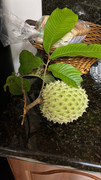I had been thinking for a while that since cherimoyas originated in the highlands of Peru, and that Peru has all kinds of weather regions (from very cold to very hot), that there might be varieties in Peru that have adapted to hot climates over the centuries. So, for a while I had been searching in different places, asking friends I have in Peru, etc..., but couldn't find anything conclusive. I also contacted a couple of agricultural research stations in Ecuador, but they didn't know.
Recently, however, I found the video I'm linking here. This video is about pruning, yet goes into other details about cherimoyas. It is presented by a lady called Maria Elena Rojas, who is the manager of an agricultural research station in Peru. Around minute 25, while she is talking about choosing the right variety for your area, she explains that there ARE VARIETIES FOR THE JUNGLE. The jungle she's referring to, is the Amazon jungle, and that is VERY HOT and VERY HUMID.
Interestingly, she also mentions that these hot weather varieties tend to have leaves which are thinner than the cold weather varieties and have better medicinal properties. From a picture she shows (at around 25:10), the leaves look like atemoya leaves, even though these are definitely cherimoya varieties.
YouTube link:
https://www.youtube.com/watch?v=SKsODNG2nF8Sorry that the video is in spanish only...
I forget if it was in this video, or another one I saw, that they explain that these hot-weather cherimoya varieties have not been used commercially as much because people prefer to grow soursop commercially in hot weather regions, and cherimoya in the highlands. However, cherimoyas can be grown everywhere in Peru by choosing the correct variety.
I wrote an email to this lady asking to obtain seeds of these varieties but haven't received a response yet. I am still pondering what other way I can get a hold of some seeds in the future.
I thought that this would be interest to all annona lovers here....







